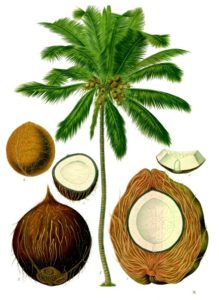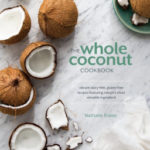
Coconut Palm Tree
One of the—or perhaps the most—complete foods, one that shares every bit of itself for human consumption
in at least 11 ways comes from the coconut palm tree. The coconut palm (Cocos nucifera) grows natively in warm, sub-tropical areas like south-east Asia and the Philippines, and South America. Its fruits have been a staple in the diets of locals there since ancient times.
Westerners discovered this bounty only when European explorers found the Philippines and the South Pacific islands travelling there between 1500-1800 AD. And so in the West, we have by turns been both enamored and fearful of its benefits ever since.
Cooking with Coconut
Natalie Fraise is the author of a cookbook featuring coconuts, coconut milk, cream, flour, aminos, butter, meat, nectar, oil, palm sugar, vinegar and coconut water:
The Whole Coconut Cookbook: Vibrant Dairy-Free. Gluten-Free Recipes Featuring Nature’s Most Versatile Ingredient. / Natalie Fraise. Photography by Erin Scott. Ten Speed Press, 2016. 122 pages, color illustrations, resources for coconut products and books about coconut, index.

The Whole Coconut Cookbook by Natalie Fraise does justice to the legacy of this royal fruit of the Areca (palm) family. Fraise created recipes in her own personal version of French culinary tradition that highlight all the various foods from the coconut, except its coir, or hardy hairy outer shell. Two of the versatile coconut foods will surprise you: coconut vinegar and coconut aminos and these replace apple cider- or white-vinegar or soy sauce, depending on the dish. Then of course there’s coconut milk and cream–the indulgence we seek in desserts and snacks. As well, coconut milk and coconut cream are found in any recipe calling for milk and cream such as mains, salads, sides and drinks. Coconut flour is my favorite replacing grain flours quite nicely in baked goods—you can eat, no, absolutely gorge! on a coconut-flour baked sweet without a lot of guilt.
Vegans and vegetarians will enjoy a good portion of this cookbook, with many of the recipes sympathetic to non-animal substance eaters. Not the least because the photography is so inviting. Erin Scott’s lens is agreeable to the task of portraying a dish as dazzling, or if you like, delectable and especially plated for coconut lovers. Looking at the illustrations you can almost taste the variety and texture in Zucchini, Fennel and Radish Carpaccio, p. 60-61 or Herbed Coconut Hummus, p. 88-89; the sweet and creamy morning goodness in Coconut Yogurt with Raspberry Pomegranate Coulis and Toasted Seeds, p. 15.
Fraise’s Grain-Free Raspberry Almond Muffins or her Grain-Free Pancakes with Orange-Vanilla Whipped Cream are pictured just as you might imagine—so elegantly tempting, these breakfast comfort foods. What makes the Raspberry Almond muffins so appealing is their color—deep golden brown, set off with raspberries both in the batter and finally resting in a small pool of honey atop the baked goods.
I’d go for the Roasted Squash and Swiss Chard with Green Coconut Harissa any day, but especially since the image of that dish shows squash delightfully laced about with shredded chard and studded with pomegranate seeds and bits of walnuts. The vegetables are conventionally roasted in a 400-degree oven and then spooned over shredded chard with minced ginger and allowed to wilt under the heat of the roasted squash.
Harissa is a wet spice mixture usually made with hot pepper and garlic, and sometimes added during cooking for a piquant taste. Fraise’s is prepared with garlic, jalapeno pepper, parsley, lime juice, spices and processed with coconut meat and milk, served raw with the vegetable salad.
Some of the easiest recipes from the standpoint of skill have loads of ingredients. Looking closely, you see that Coconut Orange Cookies are made with 7 of the coconut ingredients, one of them being coconut flour and supported by almond flour. Coconut sugar imparts a deep caramel flavor and along with coconut oil, butter and nectar create a very rich undertone for the vanilla and zest of orange. There are also Date and Almond Truffles, which are essential if you like raw desserts, and Almond Vanilla Chia Pudding with Roasted Blueberries, which is made elegant with toasted fruit.
Each chapter, from Breakfasts to Desserts, begins with an explanation on how coconut works to amplify taste in main dishes, salads & sides, drinks and desserts. Each recipe contains forethought and tips. Recipes can be achieved that parallel Fraise’s illustrations, where those are given. With just a bit of cooking knowledge, not necessarily a chef’s experience, readers can serve undoubtedly gourmet dishes with Fraise’s recommendations in The Whole Coconut Cookbook.
A goal of the book must be to showcase the versatility of the coconut and its 11 products within the terroir of gourmet cuisine. Fraise’s love of the fruit and its liquids cannot be missed, beginning with a personal relationship with it that began in childhood on the island of Madagascar. Being of French background, the sweet memories of childhood favorites and the richness of dairy still linger, inspiring her to cultivate a pleasurable experience with coconut milk, coconut meat, or nectar, cream, sugar, butter, etc. In the chapter on Desserts, Fraise quips, “… the dairy-free versions are just as flavorful as the ones I remembered.”
Follow


